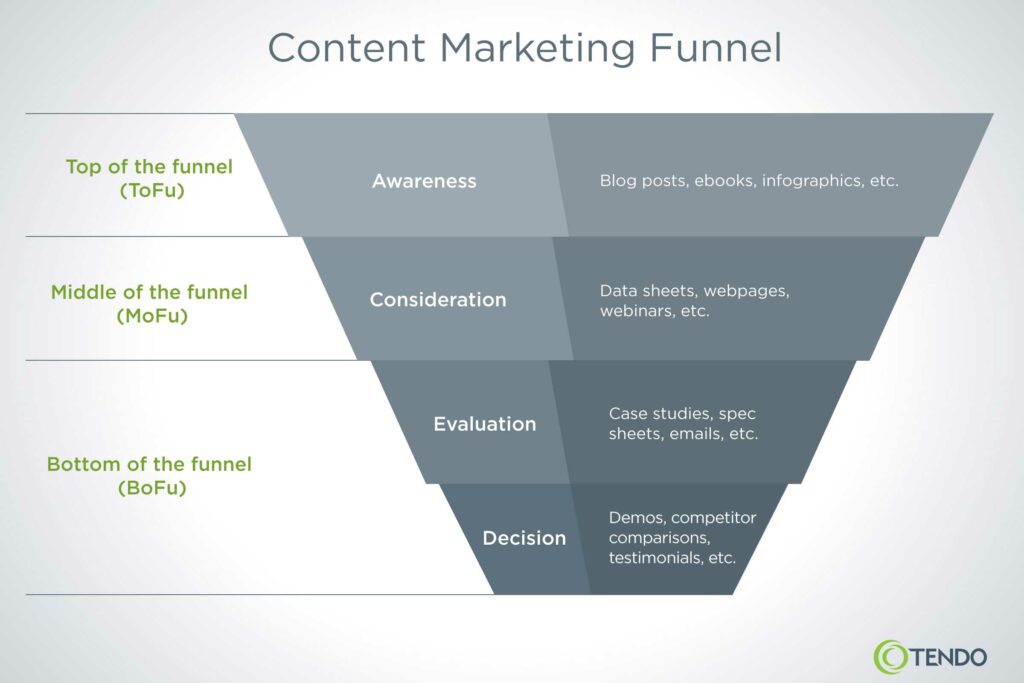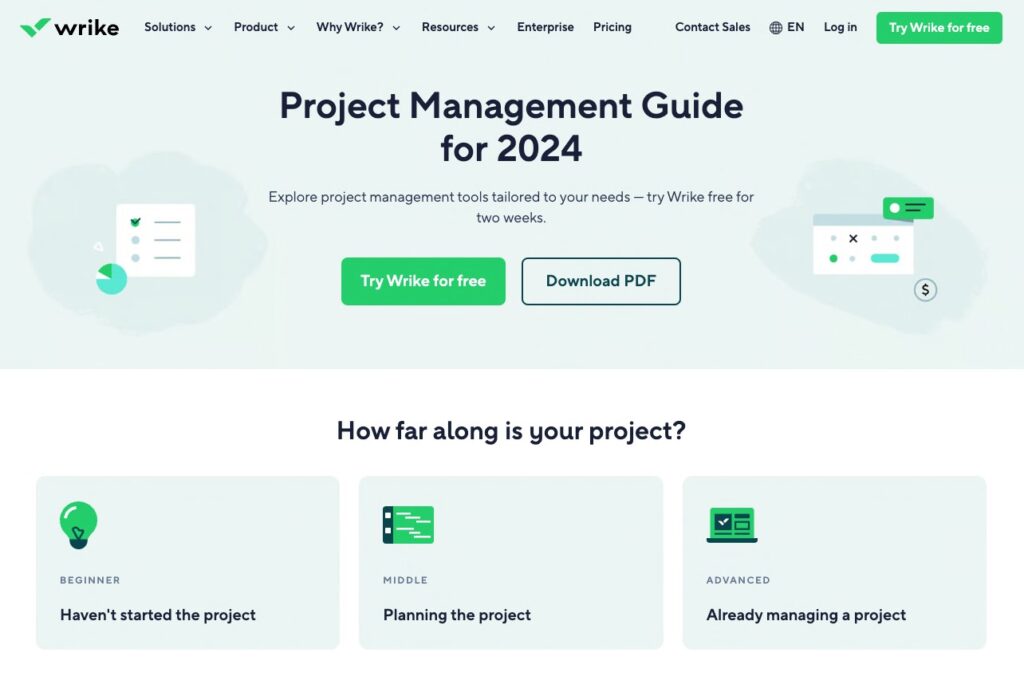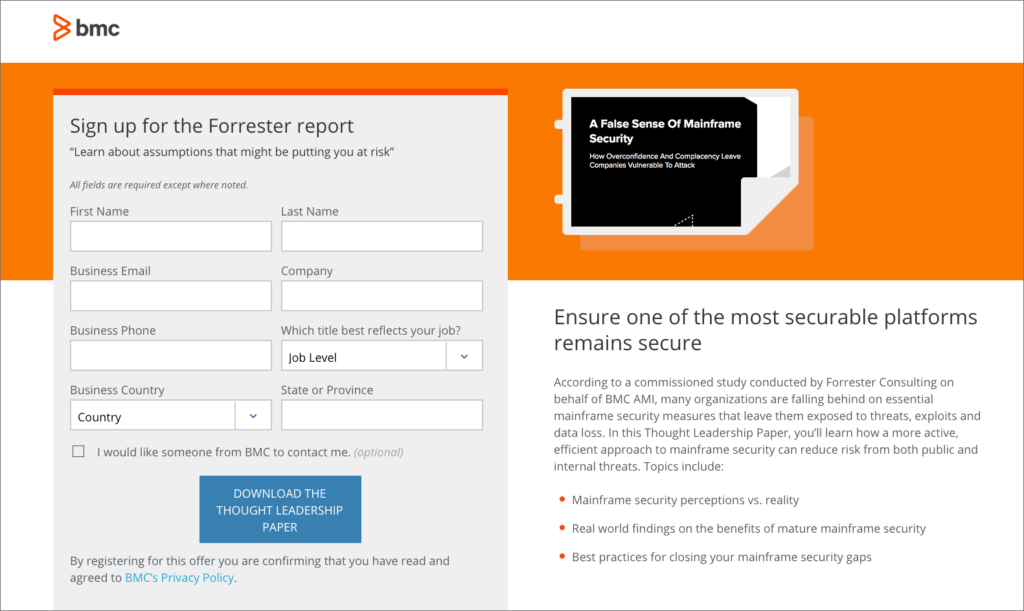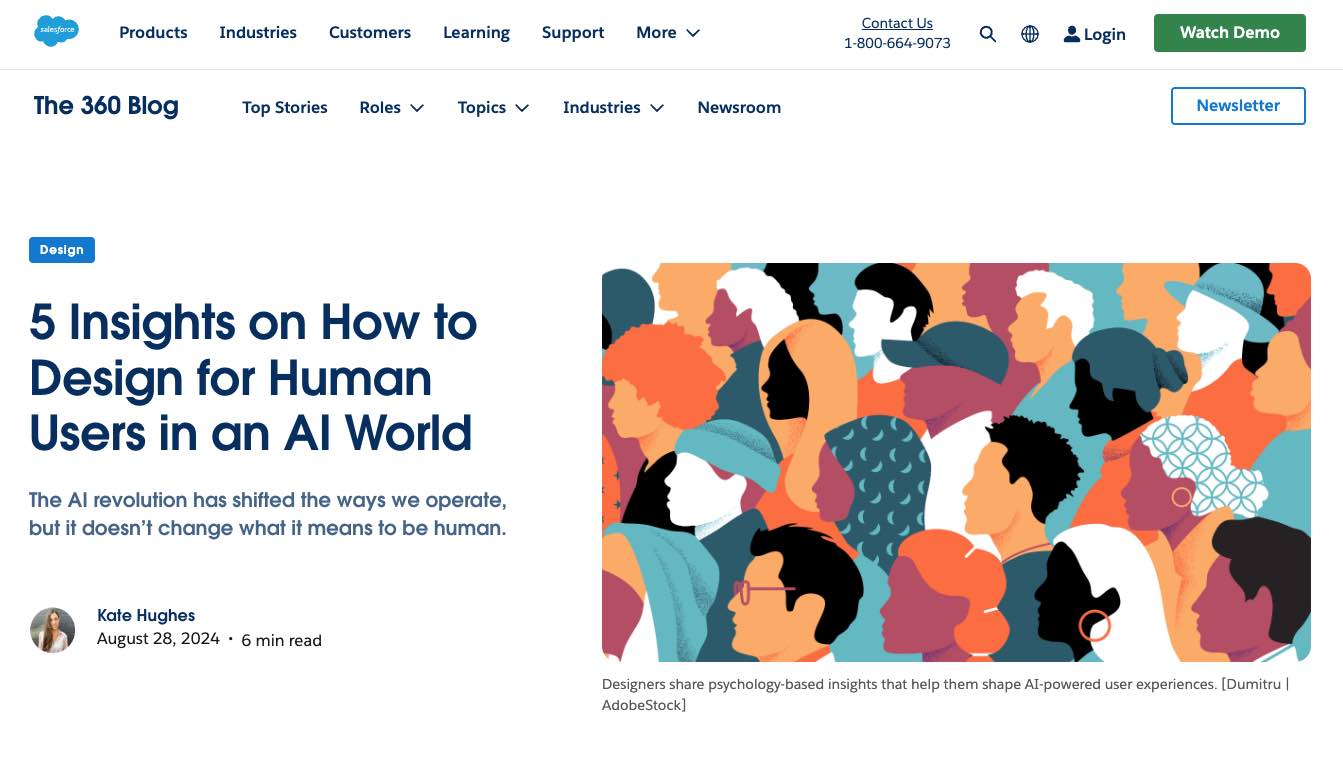Imagine if your buyers read a quick data sheet, talked to a sales rep for 15 minutes, and said, “Yup, I’m ready to buy.” Life would be sooo much easier for digital marketers. But that’s not the way it works, is it? For starters, that particular B2B buyer should be fired: He didn’t take time to research options and make a careful, well-informed decision.
To win over decision makers, marketers need to provide top of funnel or ToFu content to nurture their interest and build a relationship. Business-to-business (B2B) content marketing does the heavy lifting at this early or ToFu stage, also called the awareness stage. In fact, 87% of B2B marketers say that content marketing helped them build brand awareness over the past year, according to the Content Marketing Institute’s (CMI) B2B Content Marketing Benchmarks, Budgets, and Trends: Outlook for 2025.
Marketers put a tremendous amount of effort into top-of-funnel content, so let’s talk about how to do it right. Here are the top nine things you need to know:
- Top of funnel is where content marketing begins.
- ToFu content focuses on your target audience—not on you.
- Buyer personas lay the groundwork for great ToFu content.
- Success hinges on a larger content marketing strategy.
- A diversity of ToFu content formats pays dividends.
- Connected content experiences accelerate the customer journey.
- Content distribution can make or break ToFu marketing efforts.
- You must be better than your content competition.
- ToFu content recipe: plan, create, measure, optimize, repeat.
1. Top of Funnel Is Where Content Marketing Begins
Let’s get on the same page with definitions and terminology. What exactly is the top of the funnel, and what does content have to do with it?
Content is now central to every digital journey, every customer touchpoint. The classic marketing and sales funnel (see image below) provides a basic understanding of the customer journey and how to approach the business of content marketing.

At each step of this customer journey, your B2B prospects and leads need information (aka content) that addresses their pain points, answers their questions, articulates solutions, and conveys value propositions. A common content marketing strategy is to create content that addresses the specific needs of buyers at three primary funnel stages:
- Top of funnel (ToFu): The top is wide because you’re engaging potentially thousands of prospects with your helpful content. We’re talking a reach of thousands more than will ever end up buying your product or service. But that’s the numbers game: Start big, and cast a wide net. Engaging, high-quality content—focused on your audience’s needs—is what captures their attention at this stage, also known as the awareness stage.
- Middle of funnel (MoFu): A much smaller subset of these prospects will actually engage with your content and express initial interest in your solution. When they’ve reached the middle of the funnel, or the consideration stage, your content will continue to nurture their interest, provide helpful solutions, and, now, position your company as the best solution. Note: Buyers can also enter the funnel here, skipping ToFu, if they’ve already done extensive research on their own (which is very common).
- Bottom of funnel (BoFu): As the funnel narrows further, a handful of initial prospects are now ready to buy and are strongly considering your solution or service. The content you create at this stage zeroes in on your solution’s technical features, benefits, ROI, and success stories with other customers. Content helps close the deal. BoFu can further be segmented into evaluation and decision stages.
Some marketers use ToFu, MoFu, and BoFu as shorthand to describe the stages of the funnel, while others prefer to label stages with awareness, consideration, evaluation, and decision. Still others have abandoned the funnel concept for a flywheel or cycle. (But let’s not get into that debate.)
The point is, whether you say “ToFu content” or “awareness stage content,” you’re talking about content whose purpose is to engage professionals at the very beginning of their customer journey, often before they’re even considering a purchase.
“When ToFu content is designed well, it builds trust, creates connection, and encourages your audience to continue their journey with you,” says Matt Thompson, Director, Demand Generation at Crownpeak, a digital experience platform and enterprise CMS.
ToFu content often functions in the service of demand generation. But generating leads and nurturing them isn’t the only goal: Top-of-funnel content goals may also include improving brand awareness, or even building trust and loyalty among existing customers.
2. ToFu Content Focuses on Your Target Audience—Not on You
At the top of the funnel, the content you create should be about helping, not selling. At this stage of the customer journey, your prospects have become aware of a challenge or pain point they need to solve, or they are conducting research on a topic of interest. They are not yet ready or interested in a pitch about products or services.
ToFu content should focus on your target audience’s needs, interests, and pain points. Provide credible tips, guidance, thought leadership, and industry best practices and solutions. If they like your content, they’ll keep coming back for more. According to CMI’s Benchmarking Outlook for 2025, 82% of top-performing marketers attribute their success to understanding their audience. Follow their lead.
Let’s look at three examples of ToFu content tailored for various B2B target audiences.



3. Buyer Personas Lay the Groundwork for Great ToFu Content
It’s OK for ToFu content to speak to multiple audiences at the same time. You want to cast a wide net. But your content marketing efforts will flop if your content assets aren’t exceptionally relevant and useful for your target audiences. That’s why creating buyer personas pays off for top-of-funnel content marketing. Your persona research will shed light on your customers’ job functions and goals, careabouts and pain points, what type of content they already consume, their objections to your solution, and much more.
A well-researched buyer persona unlocks a trove of content ideas that come from understanding what interests your target audience and how to capture their attention. You can deepen this understanding with ongoing and periodic interviews with customers themselves, or with sales reps and customer success managers who talk to customers every day.
The finishing touch is to perform SEO keyword research to zero in on the exact words and phrases your audience uses, and then to incorporate them into your content. In addition to using a keyword research tool like the ones offered by Moz and SEMrush, try out the free AnswerThePublic tool to view the actual questions searchers are asking about your topic, and then include those phrases in your content.
4. Success Hinges on a Larger Content Marketing Strategy
Too often marketers crank out random acts of content at the top-of-funnel stage: a blog post on this, an e-book on that—shiny, pretty topics created without a clear business or marketing objective behind them. The result is wasted effort.
A healthy content marketing strategy—also called a content marketing framework—establishes your marketing goals and KPIs, defines your target audience, and outlines the content strategies and tactics you’ll use to engage your audience and convert them to leads and customers. Every content asset serves a purpose.
A content strategy allows marketing teams to be methodical, consistent, and able to publish a steady drumbeat of content throughout the year. Keep in mind that since the B2B buying process is typically lengthy and complex, top-of-funnel content often takes a long time to generate its full ROI.
5. A Diversity of ToFu Content Formats Pays Dividends
A healthy content marketing mix should include a range of content formats. You want your target audience to be able to consume content in their preferred format and channel. If someone isn’t ready to download a lengthy white paper, they can click a LinkedIn share on the topic, view a teaser video, or read the summary blog post. Give them options!
The blog post reigns as the most commonly encountered B2B content type. But there are so many other creative formats that can act as lead magnets at top of funnel:
- Long-form article
- Social media post
- Webinar
- Podcast
- Video
- E-book/guide
- Infographic
- Image
- Presentation
- Quiz or poll
- Checklist
- Email newsletter
6. Connected Content Experiences Accelerate the Customer Journey
Let’s assume you’re a content pro and that you’ve created a wealth of truly fantastic ToFu marketing content. You’re getting oodles of engagement. The spigot is flowing with qualified leads. Now what?
Craft a content experience that gently guides your prospects further along their journey. That means considering the connective tissue between individual content assets as well as the connections between funnel stages. Think about how it all works together—leading prospects from ToFu- to MoFu-focused content—and remember that the average B2B buyer consumes 13 pieces of content along this journey.
If a prospect views an e-book, what will they want to read next? Serve it up! Keep them bingeing on your content with “You may also like” recommendations and compelling calls to action (CTAs) for related content assets. Deploy retargeting ads and LinkedIn Sponsored Content to keep your brand top of mind among recent website visitors. Don’t let your prospects reach a dead end and then click away from your website, never to return.
Want advanced techniques for optimizing the content experience and guiding top-of-funnel prospects through consideration and purchase? Check out Tendo’s free e-book, The B2B Marketer’s Guide to Content Experience.
7. Content Distribution Can Make or Break ToFu Marketing Efforts
Once you create content that you know your target audience wants to read, the next challenge is getting it in front of them. ToFu content won’t help you reach your goals without a multichannel content distribution strategy. You have to know your audience’s preferred channels and meet them there.
And you have to pay. Unfortunately, quality organic reach only gets you so far in today’s competitive digital marketing landscape. Paid content distribution is a must. Consider deploying boosted social posts and social ads, Google Ads, banner ads, retargeting ads, and outbound emails to a targeted list. When you create a high-value asset like an e-book, you need to merchandise it with related social media posts, blog posts, and infographics. Make everything shareable.
8. You Must Be Better than Your Content Competition
No pressure, but your ToFu content needs to be awesome. Or at least more awesome than what your competition is putting out. Strive to create assets that your target audience can’t resist clicking on: authoritative, engaging, helpful, and credible—fresh content that reflects current trends, or evergreen content that details technical best practices and how-tos. Content that your readers will want to share with peers or decision-makers.
Review your competition’s ToFu content on a regular basis. How does your own content compare with theirs in terms of quality? What is their thought leadership angle? Do they stay current on industry innovations? No, we’re not suggesting that you steal their ideas. The point is to find your niche and differentiate your content from theirs—to make it better so that you win the web traffic instead of them.
9. ToFu Content Recipe: Plan, Create, Measure, Optimize, Repeat
We’ve covered almost all of the necessary ingredients for ToFu content success. Just two more to go: measurement and optimization.
Your content marketing strategy or plan should have specified your marketing goals and KPIs. Now it’s time to track those metrics on a regular basis to see which content assets are killing it and which ones are not.
If we’re honest as marketers, there are a lot of metrics that can make us look good even if they don’t translate into bottom-line results. I’m talking about pageviews, impressions, clicks, etc. But at the end of the day, is your content generating qualified leads, and are those leads converting and closing? How are content-generated leads performing compared to other demand-gen tactics? You need to find out.
And if the numbers don’t look great, keep at it. Even for high-performing content, don’t leave well enough alone. Continue to optimize your content on a quarterly basis. Find ways to improve it with better SEO keywords or updated best practices and statistics. Use Tendo’s content scorecard methodology to evaluate the qualitative and quantitative performance of all your content.
As Tendo EVP and Managing Director Lindy Roux says in her content optimization blog post, “In today’s competitive, content-saturated environment, you simply must revisit older content to evaluate its performance and make regular, ongoing improvements. It ain’t optional!”
Need Help Crafting ToFu Content?
Content marketing success at top of funnel takes concerted effort but also experience. Tendo Communications has generated leads for world-class enterprise B2B organizations, and we can do the same for you, too. Contact us to discuss your challenges and how we can help.
First published September 22, 2020










